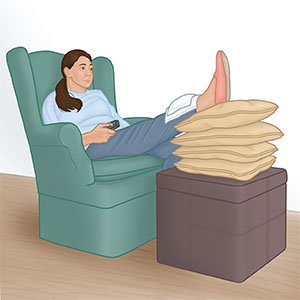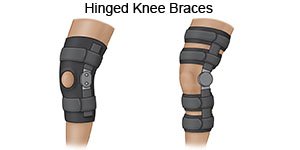Knee Dislocation
Medically reviewed by Drugs.com. Last updated on Aug 4, 2025.
A knee dislocation happens when an injury forces your thigh bone out of alignment with your shin bone. It may occur with other injuries. It can also cause torn ligaments in your knee or nerve damage.
 |
DISCHARGE INSTRUCTIONS:
Call your local emergency number (911 in the US) if:
- You feel lightheaded, short of breath, and have chest pain.
- You cough up blood.
Return to the emergency department if:
- You have severe pain and swelling in your lower leg.
- Your lower leg looks pale.
- Your leg feels warm, tender, and painful. It may look swollen and red.
Call your doctor if:
- You have leg pain that does not go away after you take pain medicine.
- You have questions or concerns about your condition or care.
Medicines:
You may need any of the following:
- NSAIDs , such as ibuprofen, help decrease swelling, pain, and fever. This medicine is available with or without a doctor's order. NSAIDs can cause stomach bleeding or kidney problems in certain people. If you take blood thinner medicine, always ask your healthcare provider if NSAIDs are safe for you. Always read the medicine label and follow directions.
- Acetaminophen decreases pain and fever. It is available without a doctor's order. Ask how much to take and how often to take it. Follow directions. Read the labels of all other medicines you are using to see if they also contain acetaminophen, or ask your doctor or pharmacist. Acetaminophen can cause liver damage if not taken correctly.
- Prescription pain medicine may be given. Ask your healthcare provider how to take this medicine safely. Some prescription pain medicines contain acetaminophen. Do not take other medicines that contain acetaminophen without talking to your healthcare provider. Too much acetaminophen may cause liver damage. Prescription pain medicine may cause constipation. Ask your healthcare provider how to prevent or treat constipation.
- Antibiotics help fight or prevent an infection. They may be given for 1 to 2 days after surgery or if you have an open wound.
- Blood thinners help prevent blood clots. Clots can cause strokes, heart attacks, and death. Many types of blood thinners are available. Your healthcare provider will give you specific instructions for the type you are given. The following are general safety guidelines to follow while you are taking a blood thinner:
- Watch for bleeding and bruising. Watch for bleeding from your gums or nose. Watch for blood in your urine and bowel movements. Use a soft washcloth on your skin, and a soft toothbrush to brush your teeth. This can keep your skin and gums from bleeding. If you shave, use an electric shaver. Do not play contact sports.
- Tell your dentist and other healthcare providers that you take a blood thinner. Wear a bracelet or necklace that says you take this medicine.
- Do not start or stop any other medicines or supplements unless your healthcare provider tells you to. Many medicines and supplements cannot be used with blood thinners.
- Take your blood thinner exactly as prescribed by your healthcare provider. Do not skip a dose or take less than prescribed. Tell your provider right away if you forget to take your blood thinner, or if you take too much.
- Take your medicine as directed. Contact your healthcare provider if you think your medicine is not helping or if you have side effects. Tell your provider if you are allergic to any medicine. Keep a list of the medicines, vitamins, and herbs you take. Include the amounts, and when and why you take them. Bring the list or the pill bottles to follow-up visits. Carry your medicine list with you in case of an emergency.
Manage a knee dislocation:
It may take weeks or months for your knee to heal. You will have to wait until you heal to return to your usual activity level. The following can help you manage your symptoms and prevent more injury while you heal:
- Apply ice. Ice helps decrease swelling and pain, and may help prevent tissue damage. Use an ice pack, or put crushed ice in a plastic bag. Cover it with a towel and place it on your knee for 15 to 20 minutes every hour or as directed.
- Elevate your knee above the level of your heart as often as you can. This will help decrease swelling and pain. Prop your knee on pillows or blankets to keep it elevated comfortably.

- Prevent your knee from moving for up to 6 weeks or as directed. Your healthcare provider may put on a cast or splint. You may need to wear a leg brace to stabilize your knee. A leg brace can be adjusted to increase your range of motion as your knee heals.

- Use crutches if directed. Your healthcare provider may tell you not to put weight on your injured knee. Your healthcare provider will show you how to use crutches. You may need them for 4 to 6 weeks.
- Go to physical therapy if directed. A physical therapist can teach you exercises to increase the range of motion in your knee. Exercises make your knee stronger, increase balance, and decrease pain. You may also need to strengthen your stomach, back, hip, and leg muscles. You may be told to continue these exercises after physical therapy ends to help prevent another dislocation.
Follow up with your doctor as directed:
Write down your questions so you remember to ask them during your visits.
© Copyright Merative 2025 Information is for End User's use only and may not be sold, redistributed or otherwise used for commercial purposes.
The above information is an educational aid only. It is not intended as medical advice for individual conditions or treatments. Talk to your doctor, nurse or pharmacist before following any medical regimen to see if it is safe and effective for you.
Further information
Always consult your healthcare provider to ensure the information displayed on this page applies to your personal circumstances.
